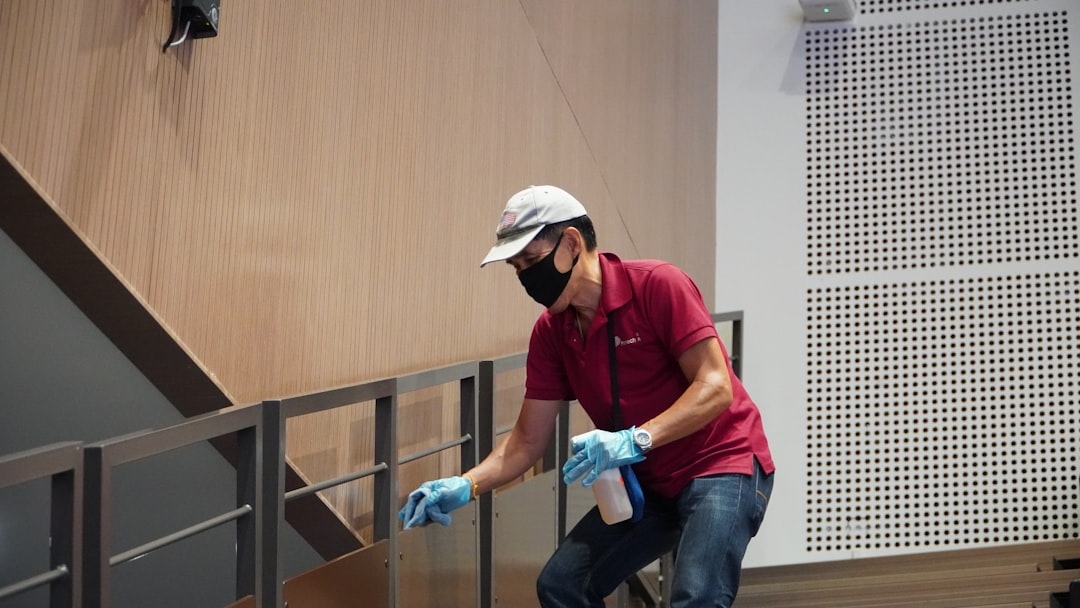

Engage prospects with a scan and streamline customer engagement with FREE QR code marketing tools by Sona – no strings attached!
Create a Free QR CodeFree consultation

No commitment

Engage prospects with a scan and streamline customer engagement with FREE QR code marketing tools by Sona – no strings attached!
Create a Free QR CodeFree consultation

No commitment
In today’s digitally driven landscape, QR codes have become essential for commercial cleaning services seeking to bridge the gap between in-person interactions and online engagement. These dynamic codes transform everyday touchpoints, such as cleaning checklists, quality assurance logs, or service confirmations, into direct digital gateways. Without requiring an app or complex setup, staff and clients can access real-time information, offer feedback, or request service updates instantly via text messages, all with a simple scan.
Traditional workflows in commercial cleaning often cause operational disruptions, as paper forms are easily lost, manual logs go unreported, and valuable signals from clients or staff are missed. This results in service errors, slow response times, and disengaged customers, ultimately hampering business growth. QR codes now enable teams to move beyond these outdated systems with creative QR ideas, introducing interactive experiences that capture every interaction and deliver insights previously out of reach. By reducing missed opportunities for data collection, companies can strengthen operational accountability and client trust.
Integrating QR code applications across all service touchpoints allows commercial cleaning businesses to streamline operations and deliver a superior client experience, with measurable results. This guide explains how strategic QR code deployment empowers seamless, secure access, closes critical feedback loops, and unlocks actionable data for smarter, more proactive decision-making.

Commercial cleaning operations often face inefficiencies from analog systems such as missed staff check-ins, incomplete paper logs, or overlooked client feedback that limit service quality and leave revenue on the table. QR codes bridge these gaps by merging offline interactions with robust digital tracking. When placed at the right points in a facility, a simple scan makes routine processes like staff attendance, issue reporting, and performance monitoring far more reliable and instantly auditable.
To enable seamless access, begin by mapping your most important on-site workflows and identifying where a scan would save time or protect quality. Then design a QR-enabled process that makes the next step obvious: scan to check in, scan to confirm the task list, scan to report an incident, or scan to request supplies. With clear calls to action and the right destinations, your staff and clients will adopt the new routine quickly, while supervisors gain real-time visibility that was impossible with paper or unstructured communication. Start creating QR codes for free.
Industry tools now streamline QR code deployment and analytics, ensuring that every scan directly feeds into workflow optimization and improved service standards. Platforms like Sona QR centralize code creation, enable dynamic redirects as processes evolve, and provide dashboards that make trends unmistakable so managers can move from guesswork to action.

A persistent challenge in commercial cleaning is the disconnect between on-the-ground service delivery and the back-end tracking needed for accountability and continuous improvement, and work management. Teams often struggle with slow feedback loops, unvalidated job completion, and the inability to spot issues before they escalate. QR codes directly address these pain points by instantly connecting physical activities to digital reports and action items, making the entire workflow visible and verifiable.
By removing the friction that keeps staff from completing logs or customers from submitting feedback, QR workflows accelerate response times and reduce service misses. A restroom door code that opens a 15-second feedback form can surface a supply shortage within minutes. A code on a machine can push a bite-size safety video to a new hire before they start. This is the quality assurance loop that manual systems rarely achieve and clients increasingly expect.
For cleaning service providers, the value compounds across sites and shifts. Each scan becomes a data point that strengthens accountability, informs scheduling decisions, and justifies service levels during audits or contract reviews. In other words, the entire operation becomes measurably better.

Commercial cleaning teams operate in fast-paced, fragmented environments where communication breakdowns are common. Different QR formats can be matched to specific needs so the right action is always one scan away. While web links and form codes often cover most use cases, the full toolkit extends to contact cards, messaging, and connectivity.
When you standardize which format to use in each scenario, the experience becomes predictable and efficient. For example, operational tasks often route to web links or forms, while urgent incidents use pre-filled SMS or email to reach the right supervisor instantly. This consistency reduces training requirements and improves adoption for new staff or contractors.
A centralized platform such as Sona QR lets you generate and manage these formats in one place, update destinations without reprinting, and review performance by code type. As compliance or client needs evolve, the ability to switch a destination or embed new logic makes your QR system future-ready.
Many commercial cleaning businesses have underutilized feedback channels and minimal engagement after service delivery. It is common to see missed upsell moments because there is no easy digital path from a completed job to a client review, follow-up request, or value-add service. Mapping QR codes to pivotal touchpoints solves this, transforming routine surfaces into engagement hubs.
The most effective placements connect moments of attention to simple actions. The goal is not more codes, but better code-to-context fit. Spatial logic matters: a scan point that is highly visible, clearly labeled, and easy to act on outperforms a code that lacks a direct benefit or sits outside the natural flow of work.
Cleaning teams that embed QR codes at strategic points report more actionable insights, improved resource allocation, and higher client retention over time. As patterns emerge in scan data, you can prioritize training, add capacity to high-traffic sites, and propose contract expansions with evidence, not assumptions.

Missed check-ins, lost incident reports, and preventable knowledge gaps are chronic issues in multi-site cleaning operations. QR code initiatives turn these pain points into opportunities. When scanning becomes a habit and each code leads to a well-designed outcome, your most persistent operational weaknesses start to fade.
The following use cases are both practical and proven. They integrate naturally into the workday and help management maintain a continuous line of sight into service quality, staffing, and customer sentiment.
These applications transform static processes into living data streams. They reduce errors and missed follow-ups, while creating a foundation for better performance reviews and client reporting. Over time, they also become a differentiator in sales conversations, since you can show exactly how you prevent service misses and respond quickly when issues arise.
A frequent pain point in commercial cleaning is fragmented data that cannot support segmentation or retargeting. Modern QR campaigns change that. Each scan carries context, such as location, time, and purpose, and can be tied to an account or user identity. The result is an audience you can nurture with messages that match the moment. See Sona’s Playbook titled Intent-Driven Retargeting: Driving High-Impact Campaigns with First-Party Intent Signals.
Segmentation matters across both sales and retention. A facility manager who scans an invoice to leave a review signals a different intent than a property manager who scans a brochure at a trade show. With unique codes aligned to journey stages, you can follow up with relevant offers instead of generic reminders.
With tools like Sona QR, every code becomes a smart entry point. You can pass UTM parameters, stamp the source, and associate a scan with an account so retargeting is based on real behavior, not guesswork. This improves conversion rates and keeps your sales and operations teams aligned.
For commercial cleaning providers, traditional print and offline media often fail to drive repeat engagement because there is no easy digital off-ramp. QR codes fix this by converting fleeting touchpoints into digital interactions you can measure. From brochures to on-site signage, one scan moves someone from passive awareness to active engagement.
The key is to choose placements your audience already uses and to make the next step obvious. A brochure at a facility tour should open a pricing estimator. A restroom door poster should launch a quick feedback form. The right match between medium and destination turns your offline channels into reliable demand drivers.
By consolidating QR-driven interactions in a central platform, you gain clarity on which channels create real value. You can double down on placements that drive high-intent scans and rework those that do not perform, all with evidence captured in the field.
Successful QR initiatives do not happen by accident. They start with a clear business objective, a format that fits the task, and a controlled rollout that you can learn from. Treat each deployment like a mini-campaign with defined metrics and a plan for optimization.
For commercial cleaning providers, the most common objectives include improving feedback response rates at priority sites, reducing missed check-ins, or accelerating incident resolution. Choose one, build a simple flow that addresses it, and validate the experience with a small pilot before scaling.
Well-executed QR campaigns prevent missed interactions, increase coverage, and enable rapid course correction. Over time, your checklists, training, and incident reporting become a living system that adapts to the realities of each facility.
One of the hardest parts of running a commercial cleaning operation is proving how daily activity drives business outcomes. When much of the work happens after hours and away from headquarters, it is easy for evidence to remain fragmented. QR platforms solve for missing visibility by delivering end-to-end attribution that ties scans to service renewals, upsells, and improved NPS. For strategy on measurement, read Sona’s blog post titled The Essential Guide to Offline Attribution.
With the right setup, you are not just counting scans. You are understanding who engaged, what they did next, and how that contributed to account health. This is how cleaning leaders justify investments, prioritize operations, and elevate the conversation from cost to value.
Sona QR centralizes these insights. With Sona for identity resolution and multi-touch attribution, you can associate scans with known buyers and understand their role in pipeline creation, pilot expansions, or contract renewals. This linkage is what transforms QR codes from a utility into a performance engine.
Rolling out QR codes is not just a technology shift. It is a behavior change. Success depends on how well you integrate scan habits into daily routines and how clearly you explain the benefit of scanning to staff and clients. Pair simple, useful actions with automation so every scan leads somewhere valuable.
When in doubt, start small and iterate quickly. Test different placements, words, and incentives. The right message at the right moment can double engagement. The wrong one often fails silently.
By embedding QR management into training, analytics reviews, and client check-ins, you create a loop of ongoing improvement. The more your team and clients see results from scanning, the more the habit sticks.

Evidence from the field shows how quickly QR deployments can move the needle when they are designed with intent. The common thread is a simple path from scan to useful action, backed by analytics that inform what to do next. For a quick overview of tactics in action, watch this video walkthrough.
Below are examples that highlight operational gains, faster onboarding, and pipeline growth. Consider where these patterns might apply in your context and adapt the placement, message, or incentive to your facility types.
These stories reinforce a principle: simple, well-placed codes that serve a real need are enough to unlock measurable improvement. Aim for clarity first, then scale.
Choosing the right QR implementation is as important as placing the code in the right spot. Static and dynamic codes each serve a purpose, and integrations determine how well scans translate into operational performance. Matching the tool to the task keeps your deployment maintainable and effective as needs change.
As your footprint grows, dynamic control and system integration become more valuable. Being able to update destinations across hundreds of codes or trigger workflows based on scan data is the difference between a useful program and an indispensable one.
A careful evaluation reduces the risk of incomplete data, missed audit deadlines, or fragmented visibility across sites. If you anticipate growth, build on dynamic codes and integrated tools from the start.
Across commercial cleaning, missing or incomplete operational records are a leading cause of failed audits and client dissatisfaction. QR-enabled processes have delivered consistent improvements because they reduce friction at the source and make accountability automatic.
Real-world benchmarks point to strong gains in speed, transparency, and retention. The numbers vary by deployment maturity and facility type, yet the trend is clear: QR codes replace uncertainty with evidence, which strengthens both operations and client relationships.
QR codes are no longer a novelty in commercial cleaning. They are a strategic lever to connect in-person service with digital accountability, close information gaps, and capture every opportunity for feedback or follow-up. Each scan simplifies engagement and turns previously anonymous interactions into actionable insight.
Forward-thinking cleaning businesses are using QR-enabled workflows and analytics to eliminate inefficiencies that once felt unavoidable. Real-time data collection at every service touchpoint helps optimize staffing, maintain compliance, and lift retention and satisfaction measurably.
With integrated platforms such as Sona QR and Sona.com, you can layer person-level recognition, automated CRM enrichment, and performance dashboards on top of every scan. This turns operational pain points into sustainable advantages: a more responsive team, a more informed client, and a business that learns from every interaction.
QR codes have transformed commercial cleaning services from routine operations into interactive, data-driven experiences. Whether it’s streamlining access management, enhancing client communication, or tracking service delivery in real time, QR codes replace outdated manual processes with instant, mobile-friendly solutions that boost efficiency and accountability. Imagine having instant access to cleaning logs and service updates at your fingertips—ensuring transparency and elevating client trust with every scan.
With Sona QR, you can create dynamic, trackable QR codes tailored for your commercial cleaning needs, update them instantly without reprinting, and connect every scan to actionable insights that improve operational workflows and client satisfaction. No more guesswork or paperwork—just smarter, seamless access management and service verification.
Start for free with Sona QR today and transform how you enable access and engagement in your commercial cleaning services.
QR codes transform physical touchpoints into digital gateways that enable real-time information access, feedback submission, and service updates without complex setups, improving operational accountability and client trust.
QR codes reduce missed data collection, accelerate response times, increase client engagement, improve transparency, streamline workflows, and enable measurable improvements in service quality and customer retention.
Start by mapping critical workflows, digitizing manual steps with QR-enabled processes, defining success metrics, optimizing code placement, and using platforms that link scans to identities and trigger real-time alerts for effective oversight.
Creative uses include placing codes on janitorial closets for maintenance requests, restroom doors for feedback, equipment labels for training videos, invoices for client reviews, and promotional materials to convert offline interest into digital engagement.
By placing QR codes at natural interaction points with clear calls to action, enabling easy feedback submission, incident reporting, and follow-up requests, and integrating scan data with CRM systems to deliver personalized communication and timely responses.
Use Sona QR's trackable codes to improve customer acquisition and engagement today.
Create Your FREE Trackable QR Code in SecondsJoin results-focused teams combining Sona Platform automation with advanced Google Ads strategies to scale lead generation

Connect your existing CRM

Free Account Enrichment

No setup fees
No commitment required

Free consultation

Get a custom Google Ads roadmap for your business






Launch campaigns that generate qualified leads in 30 days or less.
